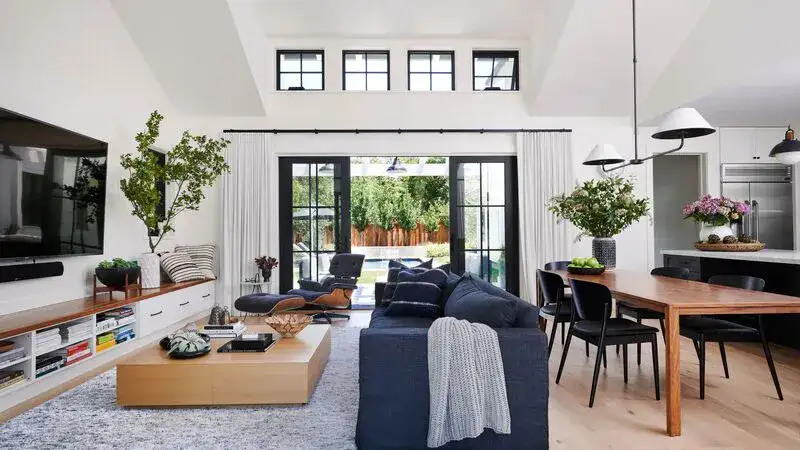How to Design an Open-Concept Living Space: Tips and Ideas

Open-concept living spaces have become increasingly popular in modern home design, and for good reason. These spaces promote a seamless flow between different areas of the home, creating an environment that feels larger, more connected, and perfect for both everyday living and entertaining. However, designing an open-concept space requires careful planning to ensure that the various areas function well together while maintaining a cohesive aesthetic. In this article, we’ll explore tips and ideas for designing an open-concept living space that is both beautiful and practical.
1. Define Your Zones
One of the challenges of an open-concept living space is defining the different areas within the space while maintaining a sense of unity. To achieve this, consider using area rugs, furniture placement, and lighting to delineate specific zones. For example, you can define the living room area with a large rug and a sofa arrangement, while the dining area can be anchored by a dining table and pendant lighting overhead.
It’s important to create visual boundaries that help to separate the different functions of the space without disrupting the overall flow. Open shelving or a console table can also serve as subtle dividers between areas, providing both functionality and a sense of division without the need for walls.
2. Choose a Cohesive Color Palette
A cohesive color palette is essential in an open-concept living space to ensure that the various areas feel connected and harmonious. Start by choosing a neutral base color that can be carried throughout the space, such as white, gray, or beige. This base color will provide a unified backdrop that allows the different areas to flow seamlessly into one another.
Next, introduce accent colors that can be used consistently across the space to add depth and interest. For example, you might choose a bold blue or green that appears in the living room cushions, dining room chairs, and kitchen backsplash. This repetition of color helps to tie the space together and creates a cohesive look.
3. Focus on Furniture Placement
Furniture placement is key to the success of an open-concept living space. It’s important to arrange your furniture to promote conversation and interaction while still defining the different zones. In the living area, opt for a sofa and chairs that face each other, creating a natural gathering spot for family and guests.
In the dining area, ensure that the table is easily accessible from both the kitchen and living areas, making it convenient for meals and socializing. If your open-concept space includes a kitchen island, consider placing stools on one side to create an informal dining or work area that connects with the rest of the space.
4. Incorporate Multi-Functional Furniture
Multi-functional furniture is particularly useful in open-concept living spaces, where versatility and flexibility are key. Consider pieces that can serve multiple purposes, such as an ottoman that doubles as a coffee table or a dining table that can extend to accommodate more guests. This type of furniture not only saves space but also enhances the functionality of your home.
In addition, consider incorporating furniture that can be easily moved or rearranged as needed. For example, lightweight chairs or stools can be relocated from the kitchen to the living area when extra seating is required, making your open-concept space adaptable to different occasions.
5. Use Lighting to Enhance Each Area
Lighting plays a crucial role in defining and enhancing the different areas within an open-concept living space. Layered lighting—using a combination of ambient, task, and accent lighting—can help create a dynamic and functional environment. For example, pendant lights or chandeliers can highlight the dining area, while recessed lighting or track lights provide general illumination for the living area.
You can use task lighting to enhance specific activities, such as under-cabinet lights in the kitchen or a reading lamp in the living room. Accent lighting, such as wall sconces or table lamps, can add warmth and highlight decorative elements.
6. Keep the Space Clutter-Free
One of the benefits of an open-concept living space is the sense of openness and airiness it provides. To maintain this feeling, it’s important to keep the space clutter-free. Invest in smart storage solutions, such as built-in cabinets, floating shelves, and storage ottomans, to keep everyday items out of sight and maintain a clean, organized environment.
Consider using decorative baskets or trays to corral smaller items, such as remote controls, magazines, and keys, helping to keep surfaces tidy and clutter-free. Regularly declutter and organize the space to prevent it from becoming overwhelmed with unnecessary items.
7. Add Personal Touches
While an open-concept living space should be cohesive and well-organized, it’s also important to infuse it with your style. Add decorative elements, such as artwork, vases, and throw pillows, that reflect your personality and interests. These personal touches can help make the space feel more inviting and uniquely yours.
Consider creating a gallery wall with a mix of family photos, artwork, and decorative objects that hold special meaning. This can be a focal point in your living area and serves as a daily reminder of the things and people you love.
Conclusion
Designing an open-concept living space requires a thoughtful approach to ensure that it is both functional and aesthetically pleasing. By defining zones, choosing a cohesive color palette, focusing on furniture placement, and incorporating multi-functional furniture, you can create a seamless flow between different areas of your home. Lighting, clutter management, and personal touches further enhance the space, making it a welcoming and versatile environment for everyday living and entertaining.